Application of Optimizing Slab Corner Shapes to Reduce Edge Seam Defect on Heavy Plates
Abstract
:1. Introduction
2. Materials and Methods
2.1. Industrial Trial Process for Optimizing Slab Corner Shape
- (1)
- Horizontal rolling: The roller for the chamfered slab corner is one roller which is placed on the left and right sides of the slab as shown in Figure 3. The top and bottom ends of the roller are provided with wheel rims, and the inclination and shape of the wheel rims are the same as the expected shape of the slab corner after rolling. The hydraulic cylinder pushes the roller in a horizontal direction and applies pressure to the slab corner through the wheel rim, so that the expected deformation of the slab corner is obtained. For the convenience of maintenance, the device is placed at the outlet of the secondary cooling chamber of the continuous casting machine.
- (2)
- Vertical rolling: The rolls for vertical rolling at the chamfered slab corners are placed on the inner and outer arcs of the slab, as shown in Figure 4, in contrast with horizontal rolling. It rolls the slab corner using the wheel rim. This rolling method can use the backup rolls in the existing segment of the continuous casting machine to increase the wheel rim to meet the need of rolling. It is suitable for the optimal deformation of slab corners with the same width and different thicknesses. If the width of the slab changes during the production process, it is necessary to adjust the position of the wheel rims or replace the roll. The operation is more complicated, especially the operation of replacing the outer arc roll.
- (3)
- Frontal rolling using a two-roller: The frontal rolling using two-roller equipment was developed in order to overcome the disadvantages of horizontal rolling on the slab corner deformation as shown in Figure 5. Although the rolling force is also generated on the slab corner from the horizontal direction, the rolling surface of the roller is approximately perpendicular to the bisector of the slab corner. The slab corner is subjected to positive pressure during the rolling process. Thereby, the stress state of the slab corners can be improved, and the occurrence of bulges and defects can be reduced.
2.2. Numerical Simulation, Methods, and Conditions
2.2.1. Numerical Simulation of the Temperature Distribution of Different Slab Corner Shapes
2.2.2. Numerical Simulation of Two-Chamfered Rolling Process
- (1)
- Mathematical model
- (2)
- Geometry and mesh
- (3)
- Boundary conditions and material properties
3. Results
3.1. Influence of Slab Corner Shape on Temperature
3.2. Effects of Rolling Methods on Slab Corner Deformation
3.2.1. The Rolling Force of Two-Chamfered Rolling
3.2.2. Rolling Resistance for the Two-Chamfered Method
3.2.3. Influence of the Two-Chamfered Method on the Deformation of the Slab Corner
- (1)
- Horizontal rolling
- (2)
- Vertical rolling
- (3)
- Frontal rolling using a two-roller
3.2.4. Stress Distribution at the Slab Corner during the Two-Chamfered Process
3.3. Industrial Applications of Two-Chamfered Technology
4. Conclusions
- (1)
- Compared with the right-angle slab and the one-chamfered slab, the two-chamfered slab has a higher corner temperature and uniformity, which is beneficial to the deformation during the rolling process.
- (2)
- The rolling force required for two-chamfered rolling by frontal rolling using a two-roller is the smallest among the three rolling methods, followed by horizontal rolling, with vertical rolling requiring the largest amount. The rolling resistance to the casting machine shows the same results. Suitable corner deformation of two-chamfered slab can be obtained using frontal rolling with a two-roller.
- (3)
- The slab with a favorable two-chamfered shape can be produced by frontal rolling with a two-roller at the optimized chamfered length. The two-chamfered slab produced by the frontal rolling of two-roller equipment can make the edge seam defect ratio on heavy plates less than 5%, even under the conditions of a large broadside ratio, and the position of the edge seam defect occurs within 10 mm from the edge of the heavy plate.
Author Contributions
Funding
Institutional Review Board Statement
Informed Consent Statement
Data Availability Statement
Conflicts of Interest
References
- Peng, Q.C.; Zhao, J.T.; Tian, J.; Chen, Y.J.; Zhang, X.H.; Peng, S.T. Analysis of surface “black line” defect in cold-rolled sheet at WISCO. China Metall. 2010, 20, 21–25. [Google Scholar]
- Yang, W.; Wang, X.H.; Wang, W.J.; Xue, Y.Q.; Shan, Q.L. Formation mechanism of a sliver-type defect on the surface of hot rolled plate. Iron Steel Vanadium Titan. 2011, 32, 34–39. [Google Scholar]
- Liu, J.C.; Hu, H.F. Analysis on the mechanism of edge black line defect on the SPHC hot rolled strip. Steel Roll. 2008, 25, 13–15. [Google Scholar]
- Pang, Q.H.; Tang, D.; Zhao, A.M.; Zhao, Z.Z. Formation mechanism of the scar defect on the surface of hot rolled plate and its control measures. Steel Roll. 2014, 31, 9–11. [Google Scholar]
- Ma, Z.W.; Zhang, H.; Hu, P.; Zhao, P.; Song, B. Simulation experiments and mechanism of medium plate edge folding. Chin. J. Eng. 2015, 37, 1630–1636. [Google Scholar]
- Sun, C.G.; Lee, G.S.; Lee, J.H.; Hwang, S.M. Mechanism of edge seam defects of stainless steel generated during hot plate rolling. ISIJ International. 2006, 46, 93–99. [Google Scholar] [CrossRef] [Green Version]
- Zhang, Y.F.; Gu, W.; Tian, S.P. The causes and control of longitudinal edge cracks of the plate. Steel Rolling 2012, 29, 16–18. [Google Scholar]
- Wen, W.X. Formation analyze and countermeasures of edge cracks defect on medium and heavy plate. Contin. Cast. 2011, 6, 43–46. [Google Scholar]
- Moir, S.; Preston, J. Surface defects-evolution and behavior from cast slab to coated strip. J. Mater. Process. Technol. 2002, 125, 720–724. [Google Scholar] [CrossRef]
- Ray, A.; Mukherjee, D.; Dhua, S.K. Microstructural features of sliver defects in hot-rolled low-carbon steel sheets. J. Mater. Sci. Lett. 1993, 12, 1148–1150. [Google Scholar] [CrossRef]
- Záhumenský, P.; Merwin, M. Evolution of artificial defects from slab to rolled products. J. Mater. Process. Technol. 2008, 196, 266–278. [Google Scholar] [CrossRef]
- Lee, S.J.; Choi, J.W. Deformation analysis of surface defect on hot rolling by 3-D FEM simulation. La Rev. De Métallurgie 2008, 105, 127–135. [Google Scholar] [CrossRef]
- Yu, H.L.; Liu, X.H.; Li, C.S. Influences of edging roll shape on the plastic strain distribution of slab during multi-pass V-H rolling process. Acta Metall. Sinaica 2006, 19, 51–56. [Google Scholar] [CrossRef]
- Yamaguchi, H.; Kusaba, Y.; Yamada, T. Improvement of seam-defects on strip edge of stainless steel. Tetsu Hagané 1996, 82, 58–62. [Google Scholar] [CrossRef] [Green Version]
- Yukawa, N.; Yoshida, Y.; Ishikawa, T. Deformation analysis of longitudinal surface micro-defects in flat rolling. Tetsu Hagané 2006, 92, 661–666. [Google Scholar] [CrossRef] [Green Version]
- Hiruta, T.; Matsubara, Y.; Era, H. Formulation mechanism of edge-seam defects on hot-rolled stainless steel: A study of edge-seam defect control on hot-rolled stainless steel I. J. JSTP 2013, 54, 913–917. [Google Scholar] [CrossRef] [Green Version]
- Hu, P. Formation Mechanism of Edge Seam Defect on Strip and the Research on Effect of Slab Chamfering. Ph.D. Dissertation, Northeastern University, Shenyang, China, 2016. [Google Scholar]
- Ma, Z.W.; Zhang, H.; Hu, P.; Zhao, P.; Song, B. Using chamfering billet improved slab edge straight crack. Shanghai Met. 2016, 38, 55–59. [Google Scholar]
- Hu, P.; Zhang, H.; Wang, M.L. Application of a chamfered slab to reduce risk of edge straight crack on hot rolled strip surface. Mater. Trans. 2015, 56, 2095–2097. [Google Scholar] [CrossRef]
- Zhang, H.; Hu, P.; Wang, M.L. Mechanism and improvement of straight edge seam defect on hot-rolled plate surfaces through use of chamfered slabs. J. Iron Steel Res. (Int.) 2016, 23, 539–546. [Google Scholar] [CrossRef]
- Gratacos, P.; Montmitonnet, P.; Chenot, J.L. An integration scheme for Prandtl-Reuss elastoplastic constitutive equations. Int. J. Methods Engieering 1992, 33, 943–961. [Google Scholar] [CrossRef]
- Johnson, G.R.; Cook, W.H. A constitutive model and data for metals subjected to large strains, high strain rates, and high temperatures. In Proceedings of the 7th International Symposium on Ballistics, The Hague, The Netherlands, 19–21 April 1983; pp. 541–547. [Google Scholar]
- Hu, P.; Zhang, H.; Wang, M.L.; Zhang, X.Z.; Zhu, M.Y. Flow behavior and deformation of Nb micro-alloyed steel during strip hot rolling. Metall. Res. Technol. 2015, 112, 508. [Google Scholar] [CrossRef]
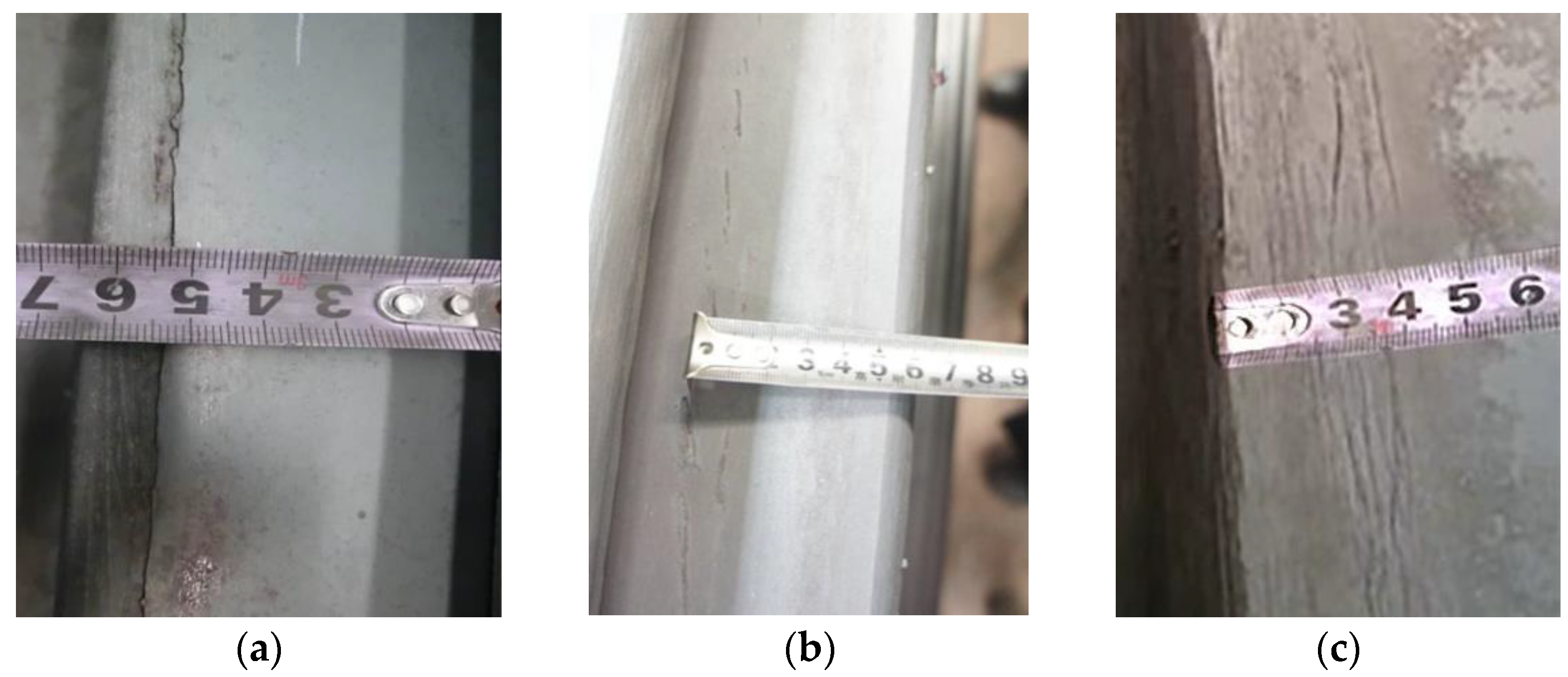



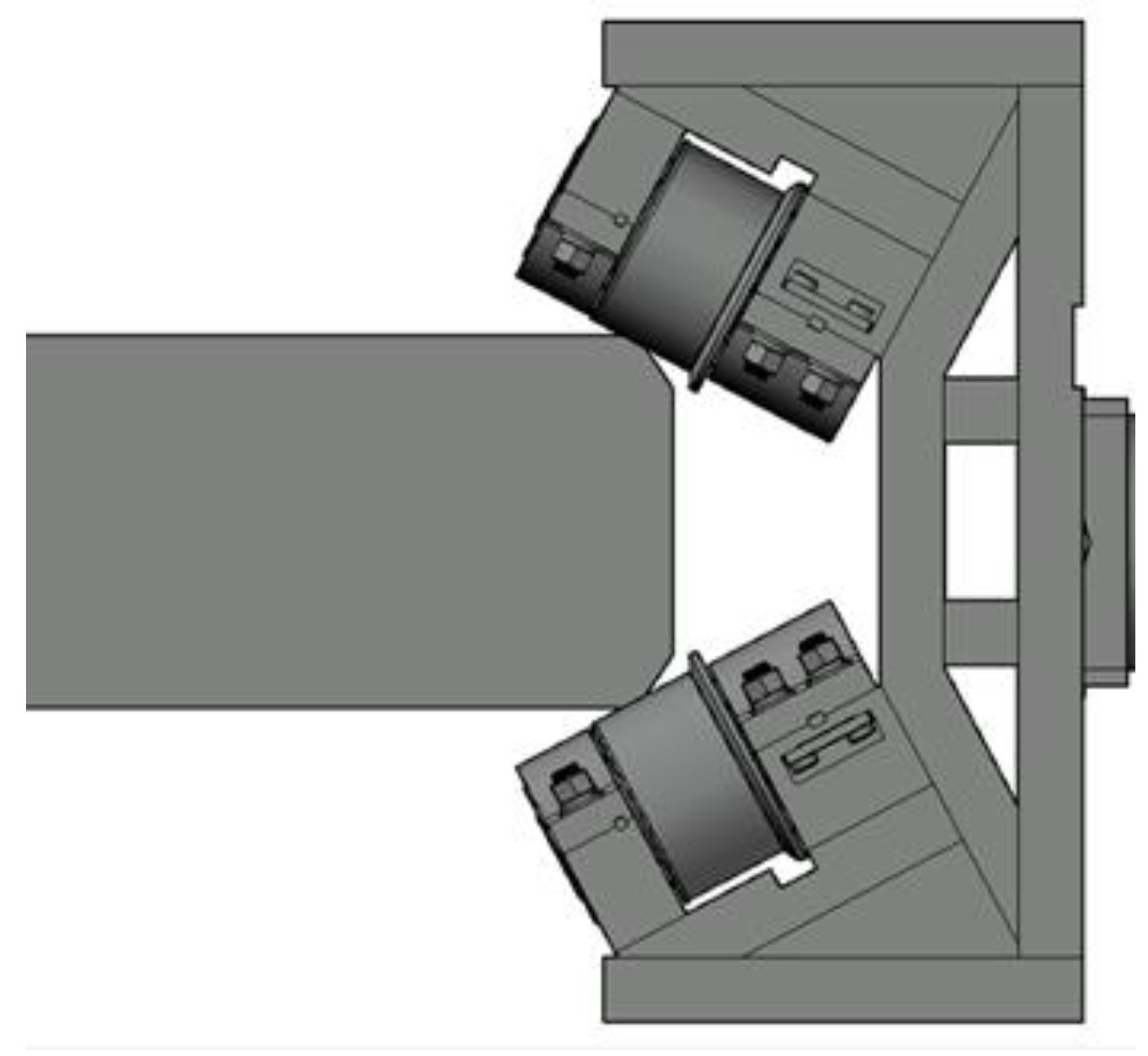
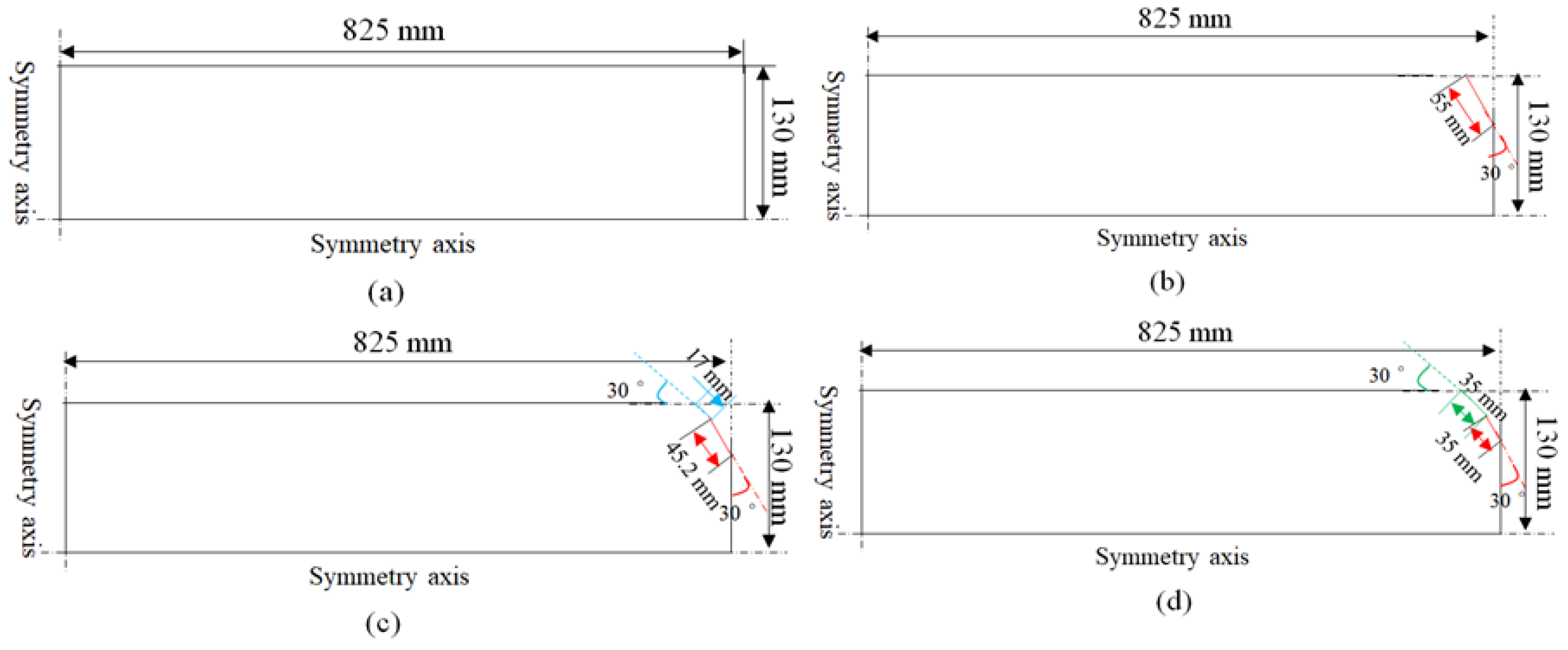

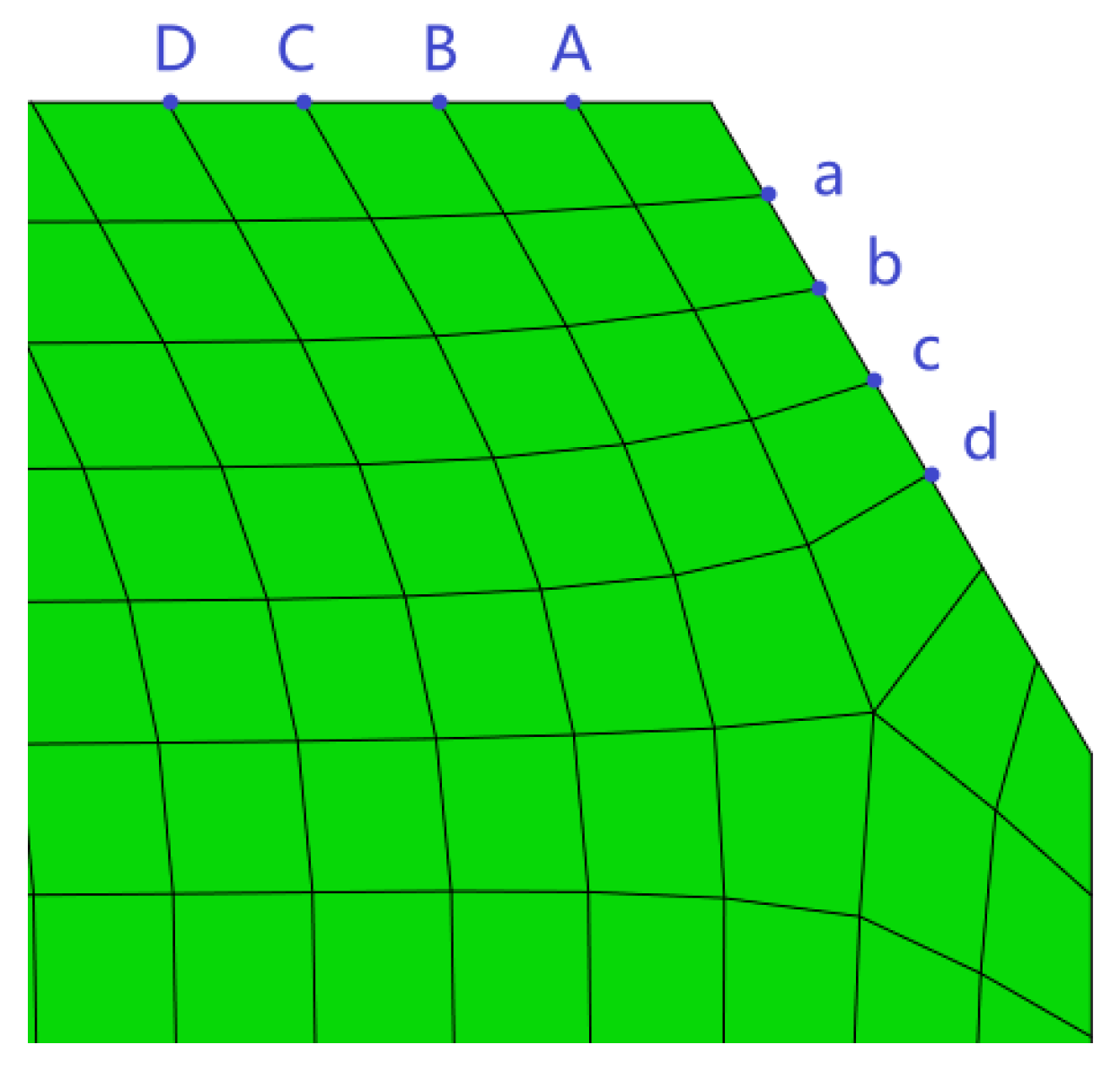
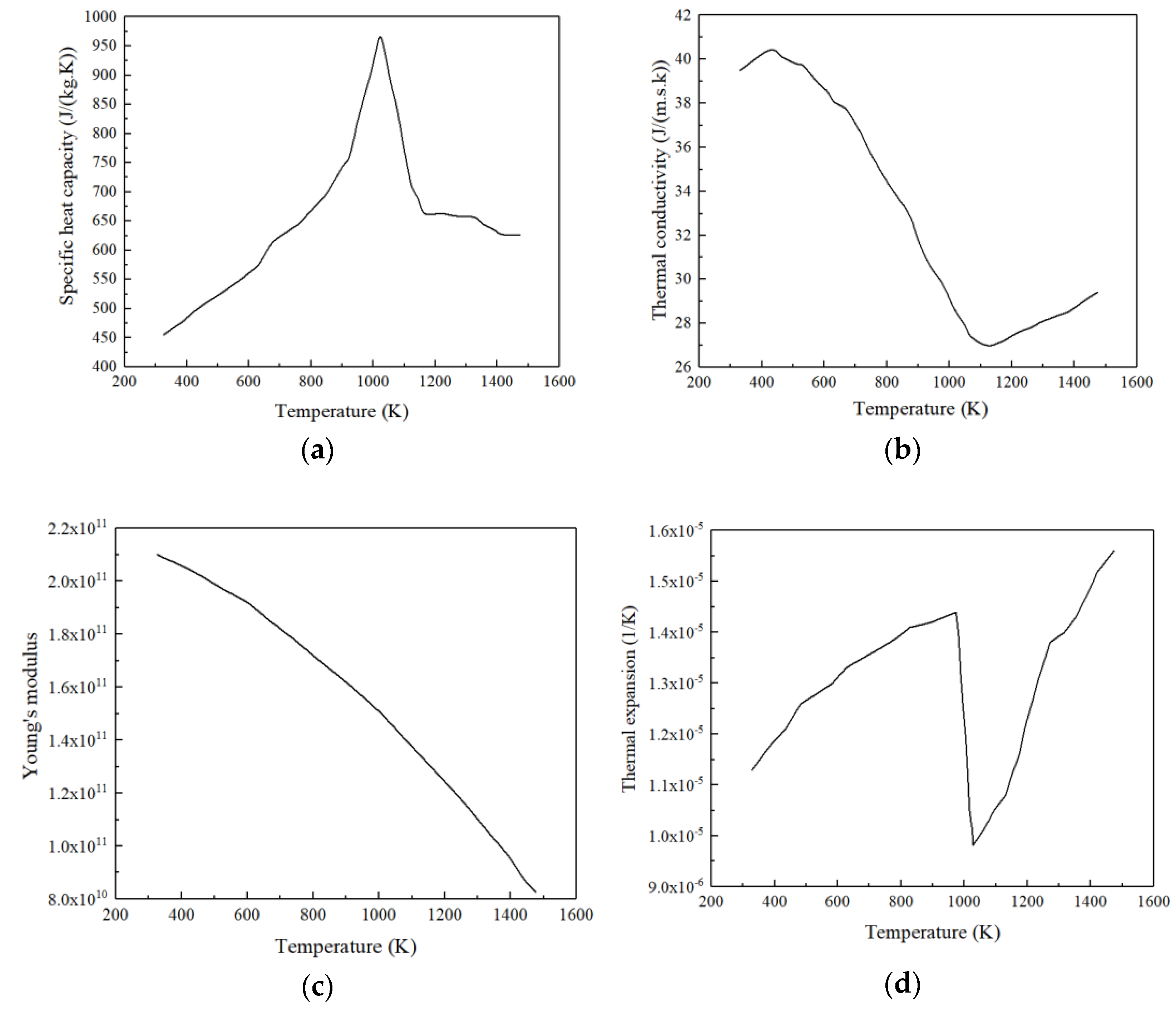



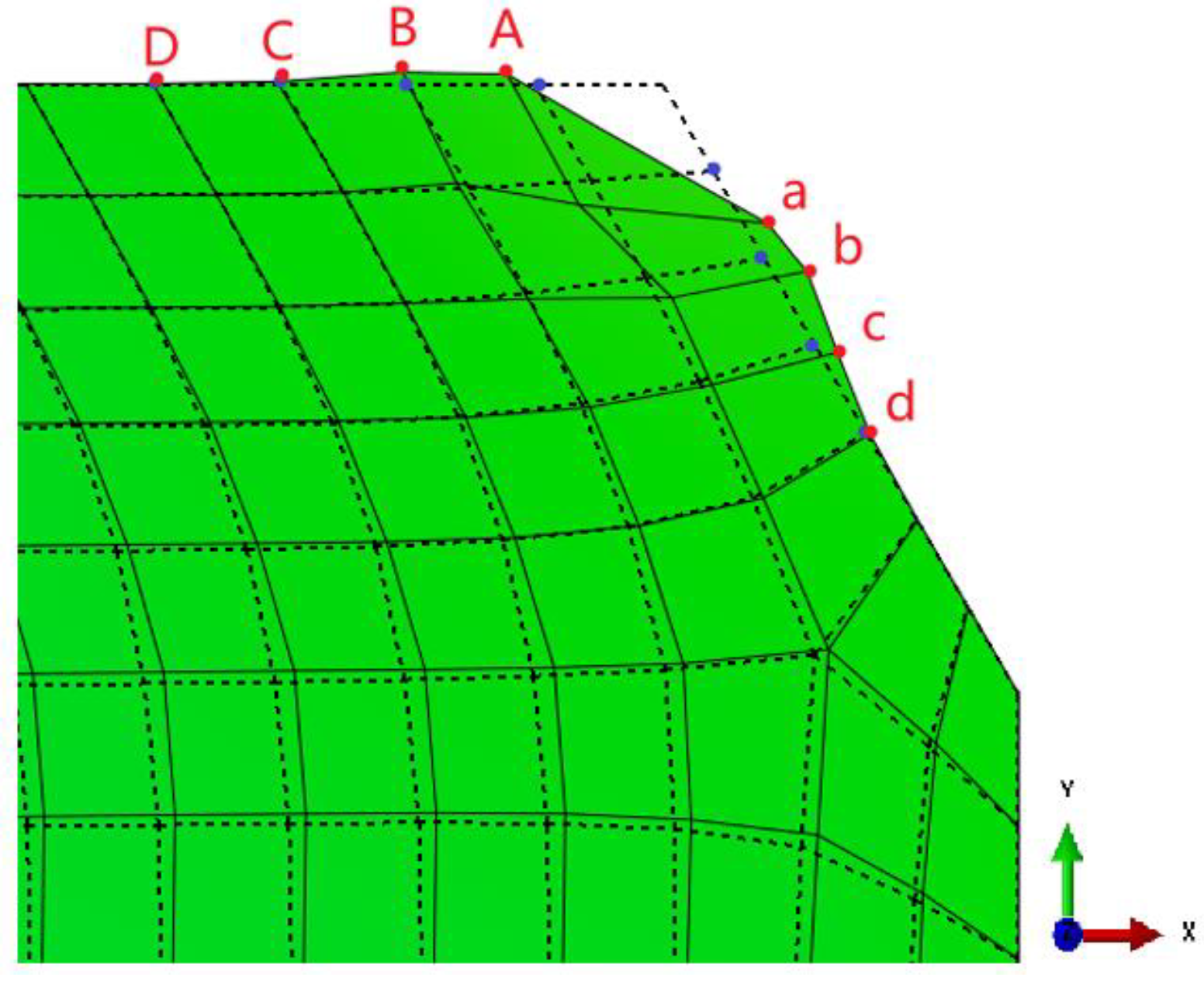


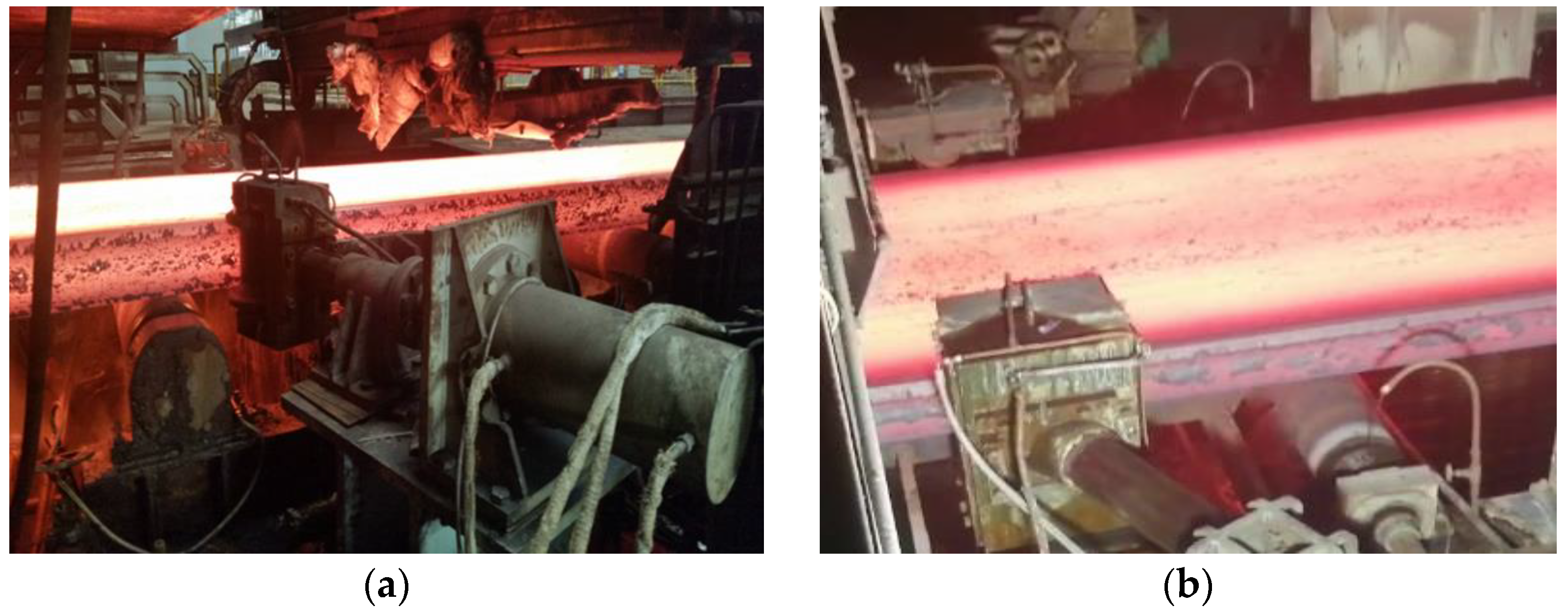
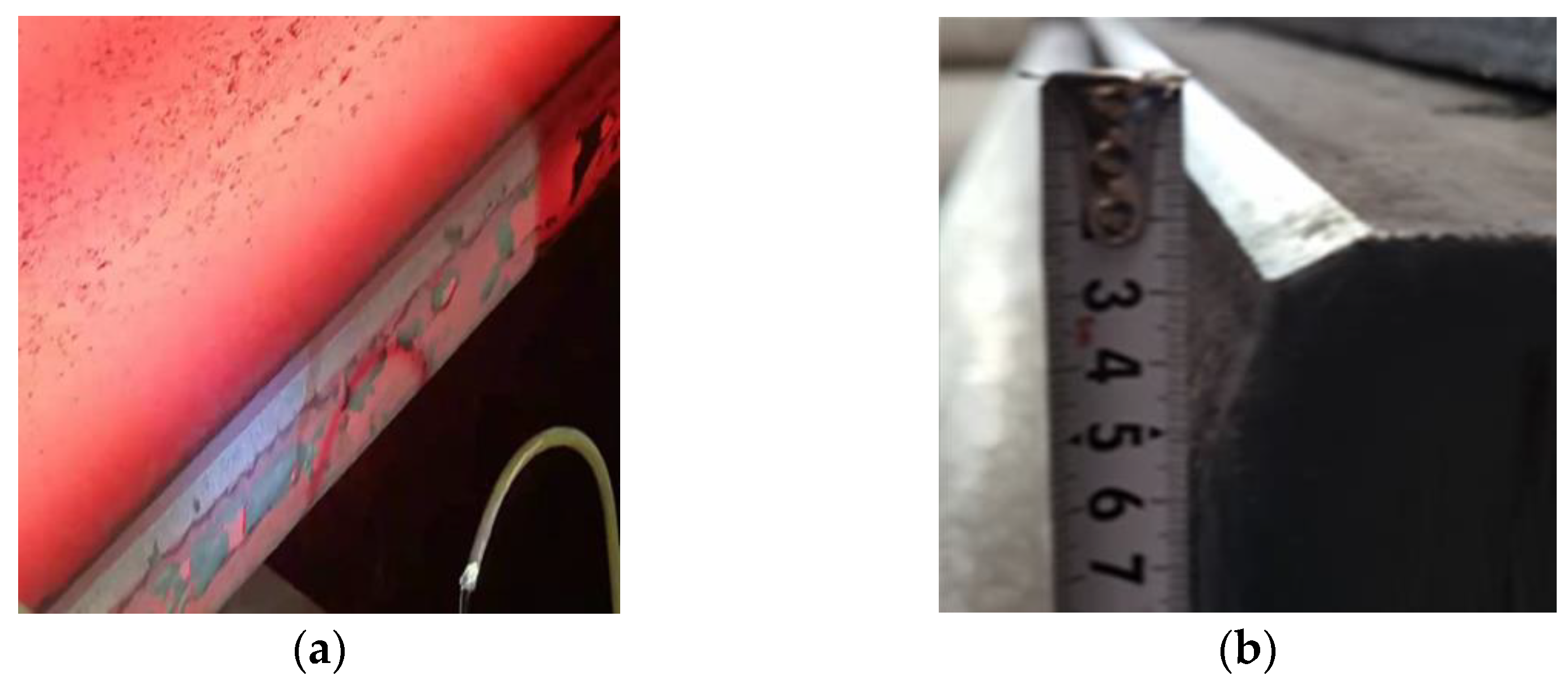

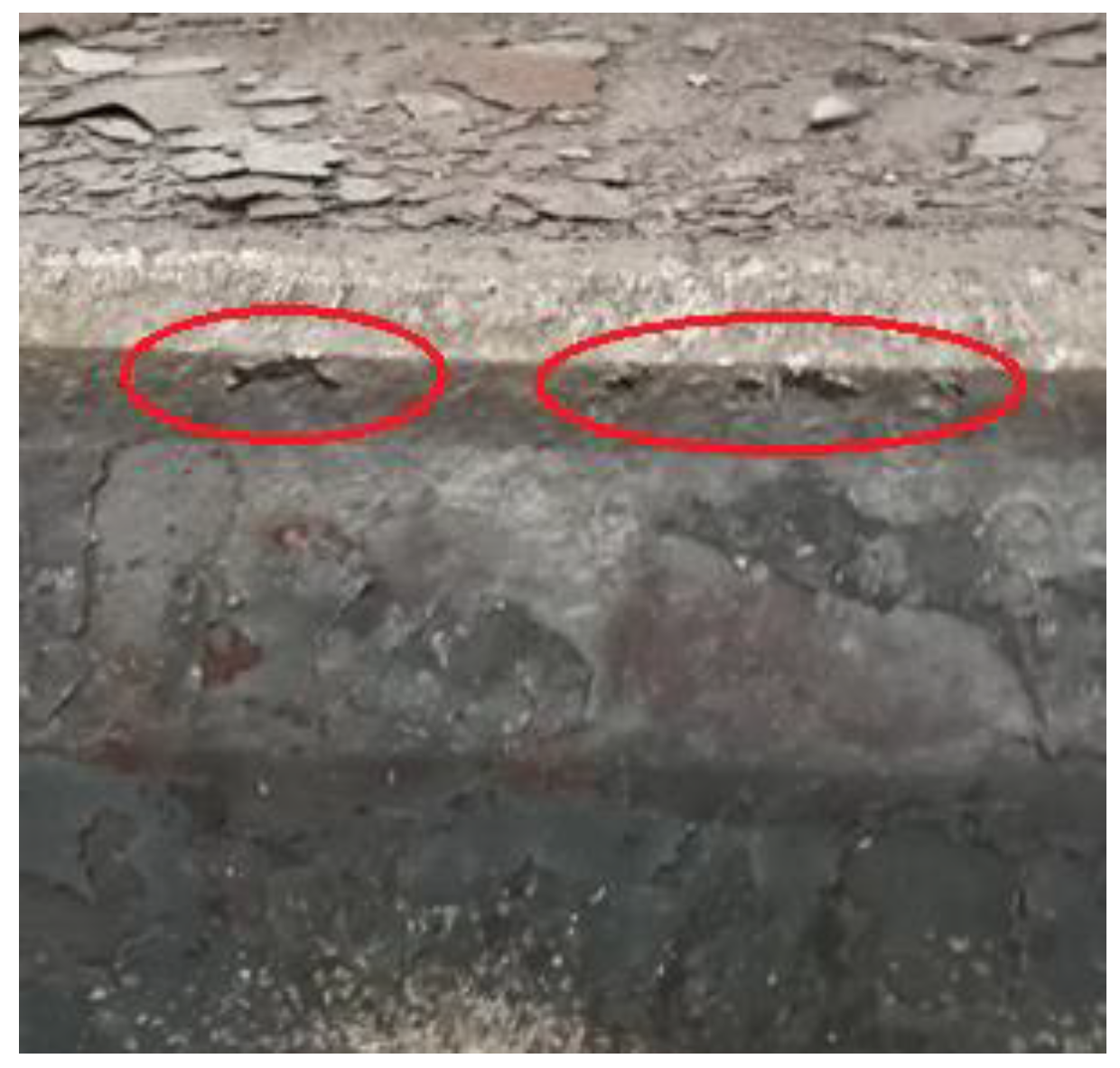
| Chamfered Length (mm) | 11 | 14 | 17 | 20 | |
|---|---|---|---|---|---|
| Rolling Methods | |||||
| Horizontal rolling | 20.8 | 31.3 | 43.1 | 53.2 | |
| Vertical rolling | 21.8 | 32.8 | 45.3 | 54.0 | |
| Frontal rolling using a two-roller | 18.6 | 29.6 | 40.4 | 48.6 | |
| Chamfered Length (mm) | 11 | 14 | 17 | 20 | |
|---|---|---|---|---|---|
| Rolling Methods | |||||
| Horizontal rolling | 5.9 | 7.9 | 11.2 | 18.6 | |
| Vertical rolling | 6.1 | 9.3 | 13.4 | 19.0 | |
| Frontal rolling using a two-roller | 5.6 | 8.0 | 11.0 | 18.2 | |
| Two-Chamfered Length(mm) | Direction | A | B | C | D | a | b | c | d |
|---|---|---|---|---|---|---|---|---|---|
| 11 | X | −3.40 | −0.10 | −0.01 | 0.01 | 1.30 | −0.01 | 0.09 | 0.02 |
| Y | 1.68 | 0.12 | 0.03 | 0.01 | −0.55 | 0.04 | −0.004 | 0.01 | |
| 14 | X | −4.60 | −0.70 | −0.12 | −0.004 | 1.40 | 0.07 | 0.09 | 0.03 |
| Y | 2.10 | 0.67 | 0.09 | 0.01 | −0.70 | 0.01 | −0.02 | 0.01 | |
| 17 | X | −6.12 | −1.90 | −0.77 | −0.01 | −0.13 | 0.13 | 0.07 | 0.03 |
| Y | 2.80 | 1.70 | 0.58 | 0.01 | −0.80 | 0.01 | −0.02 | −0.004 | |
| 20 | X | −7.90 | −3.4 | −1.8 | −0.08 | −1.63 | 0.16 | 0.08 | 0.05 |
| Y | 3.50 | 2.80 | 1.44 | 0.07 | −0.96 | −0.01 | −0.01 | −0.004 |
| Two-Chamfered Length (mm) | Direction | A | B | C | D | a | b | c | d |
|---|---|---|---|---|---|---|---|---|---|
| 11 | X | −1.67 | 0.04 | −0.04 | 0.02 | 3.11 | 0.16 | 0.21 | 0.03 |
| Y | 1.22 | 0.04 | 0.05 | 0.005 | −1.55 | −0.006 | −0.05 | 0.003 | |
| 14 | X | −2.10 | 0.13 | −0.13 | 0.01 | 3.50 | 0.58 | 0.40 | 0.03 |
| Y | 1.70 | 0.16 | 0.10 | 0.004 | −2.1 | −0.01 | −0.16 | −0.01 | |
| 17 | X | −2.30 | 0.01 | −0.23 | −0.004 | 3.90 | 1.57 | 1.03 | 0.10 |
| Y | 1.80 | 0.28 | 0.15 | 0.02 | −2.94 | −0.33 | −0.31 | −0.02 | |
| 20 | X | −2.30 | −0.5 | −0.27 | −0.04 | 4.32 | 3.50 | 1.82 | 0.34 |
| Y | 0.74 | 1.00 | 0.20 | 0.05 | −4.25 | −1.00 | −0.54 | −0.09 |
| Two-Chamfered Length (mm) | Direction | A | B | C | D | a | b | c | d |
|---|---|---|---|---|---|---|---|---|---|
| 11 mm | X | −1.94 | 0.04 | −0.04 | 0.02 | 2.30 | 0.06 | 0.13 | 0.03 |
| Y | 1.19 | 0.04 | 0.04 | 0.01 | −1.08 | 0.02 | −0.03 | 0.01 | |
| 14 mm | X | −2.6 | 0.03 | −0.07 | 0.01 | 2.88 | 0.06 | 0.18 | 0.01 |
| Y | 1.50 | 0.06 | 0.05 | 0.01 | −1.58 | −0.01 | −0.06 | −0.01 | |
| 17 mm | X | −3.2 | −0.04 | −0.39 | −0.003 | 2.57 | 0.92 | 0.59 | 0.05 |
| Y | 2.30 | 0.45 | 0.25 | 0.016 | −2.11 | −0.04 | −0.16 | −0.01 | |
| 20 mm | X | −3.79 | −0.93 | −0.44 | −0.02 | 2.66 | 2.0 | 0.99 | 0.10 |
| Y | 2.09 | 1.16 | 0.31 | 0.04 | −2.70 | −0.36 | −0.27 | −0.02 |
Publisher’s Note: MDPI stays neutral with regard to jurisdictional claims in published maps and institutional affiliations. |
© 2022 by the authors. Licensee MDPI, Basel, Switzerland. This article is an open access article distributed under the terms and conditions of the Creative Commons Attribution (CC BY) license (https://creativecommons.org/licenses/by/4.0/).
Share and Cite
Wang, M.; Zhang, H.; Zhao, W.; Liu, H.; Wang, X. Application of Optimizing Slab Corner Shapes to Reduce Edge Seam Defect on Heavy Plates. Metals 2022, 12, 1984. https://doi.org/10.3390/met12111984
Wang M, Zhang H, Zhao W, Liu H, Wang X. Application of Optimizing Slab Corner Shapes to Reduce Edge Seam Defect on Heavy Plates. Metals. 2022; 12(11):1984. https://doi.org/10.3390/met12111984
Chicago/Turabian StyleWang, Minglin, Hui Zhang, Wenbo Zhao, Heping Liu, and Xuebing Wang. 2022. "Application of Optimizing Slab Corner Shapes to Reduce Edge Seam Defect on Heavy Plates" Metals 12, no. 11: 1984. https://doi.org/10.3390/met12111984





